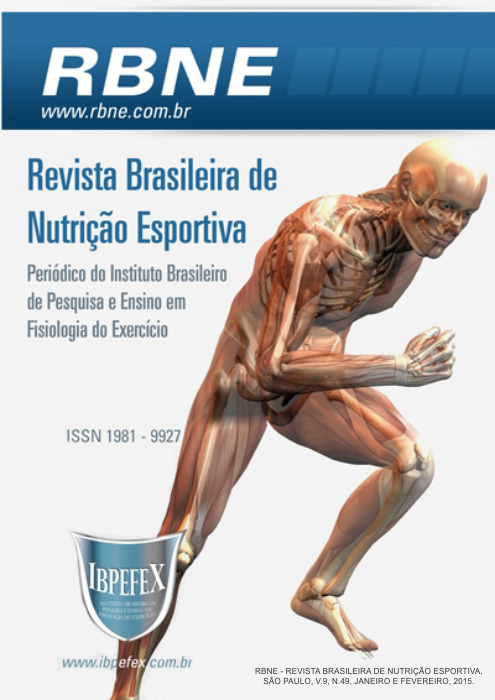Effects of carbs intake on glycemic response in street runners in the distance of 5 Km
Abstract
Introduction: The aimof the study was to analyze the glycemic responses from twenty subjects through the ingestion of high glycemic index carbohydrates, divided in groups as the following: before the run, fasting, and control. Materials and Method: the first three groups have not eaten for at least 8 hoursbefore the exam. The data was collected by the glucose measurer ACCU-CHEK®Performa, through which individual glycemic values were measured from groups receiving cereal bars and isotonic in six moments (before the test, 15 minutes after ingestion, at 1.5km, 3km and 5km spots and 10 minutes after the test). For the control and fasting groups collections were made at five moments (before the test, at 1.5km, 3km and 5km spots and 10 minutes after the test). Results and Discussion: In groups II and III, in spite of a significant increase after the carbohydrate ingestion, the glycaemia returned to levels similar to those at the beginning maintaining until the end of the session and showing no sharp decrease, which would characterize the hypoglycemic rebound phenomenon. Group I did not show any relevant variation on glycemic levels due to the stock the human body naturally has. Group IV showed a slight decrease on initial parameters. Conclusion: It is possible to conclude, by these results, that inside all the groups, in spite of the long fasting period, none of the subjects studied reached the hypoglycemic state.
References
-Altoé, J. L. Ingestão pré-exercício de um “café da manhã”: efeito da glicemia sanguínea durante um exercício de alta intensidade. Trabalho de Conclusão de Curso de Graduação. Departamento de Educação Física. Universidade Federal de Viçosa. Viçosa. 2006.
-Aoi, W.; Naito, Y.; Yoshikawa, T. Exercise and funtional foods. Nutrition Journal. Londres. Vol. 5. Núm. 15. p.1-18. 2006.
-Cabral, C.A.C.; Rosado, G.P.; Silva, C.H.O.; Marins, J.C.B. Diagnostico do estado nutricional dos atletas da equipe olimpica permanente de levantamento de peso do comitê olímpico brasileiro (COB). Rev Bras Med Esporte. Vol. 12. p.345-50. 2006.
-Cocate, P. G.; Brasil, T. A.; Marins, J. C. B. Comparação da resposta glicêmica antes e durante um exercício de baixa intensidade em esteira referente a três procedimentos de “café da manhã”. In: Simpósio internacional de Ciências do Esporte. 28. São Paulo. Anais. São Caetano do Sul. Celafiscs. 2005. p. 152. 2005.
-Costa Rosa, L. F. P. B.; Vaisberg, M. W. Influências do exercício na resposta imune.Revista Brasileira de Medicina do Esporte. Vol. 8. Núm. 4. p. 167-172. 2002.
-Costill, D. L.; e colaboradores. Effects of elevated plasma FFA and insulin on de muscle glycogen usage during exercise. Journal of Applied Physiology, Bethesda, Vol. 43. Núm. 4. p. 695-99. 1977.
-Febbraio, M. A.; e colaboradores. Preexercise carbohydrate ingestion, glucose kinetics, and muscle glycogen use: effect of the glycemic index. Journal of Applied Physiology. Bethesda. Vol. 89. Núm. 5. p. 1845-51. 2000.
-Felício, C. H. V. Resposta crônica e aguda da glicemia a um protocolo de treinamento misto para melhora da saúde de diabéticos tipo 2. Dissertação Mestrado em Promoção de Saúde. Universidade de Franca. Franca. 2008.
-Felig, P.; e colaboradores. Hypoglycemia during prolonged exercise in normal men. New England Journal of Medicine. Vol. 306. Núm. 15. p. 895-900. 1982.
-Hamzah, S.; e colaboradores. The effect of glycaemic index of high carbohydrate diets consumed over 5 days on exercise energy metabolism and running capacity in males. Journal of Sports Sciences. Vol. 27. Núm. 14. p. 1545-54. 2009.
-Mcardle, W.; Katch, F.; Katch, V. L. Energia, nutrição e desempenho humano. 5ª edição. Guanabara Koogan. 2003.
-Polacow, V.; Lancha Junior, A. H. Dietas hiperglicídicas: efeitos da substituição isoenergética de gordura por carboidratos sobre o metabolismo de lipídios, adiposidade corporal e sua associação com atividade física e com o risco de doença cardiovascular. Arquivos Brasileiros de Endocrinologia e Metabologia. Vol. 51. Núm. 3. p. 389-400. 2007.
-Salgado, M.J.V.V.; Chacon-Mikahili, M.P.T. Corrida de rua: analise do crescimento do númerode provas e de praticantes. Conexões. Vol. 4. p.100-9. 2006.
-Stannard, S. R.; Constatini, N. W.; Miller, J. C. The effect of glycemic index on plasma glucose and lactate levels during incremental exercise. International Journal of Sport Nutrition & Exercise Metabolism. Vol. 10. Núm. 1. p. 51-61. 2000.
-Wee, S. L.; e colaboradores. Influence of high and low glycemic index meals on endurance running capacity. Medicine and Science in Sports and Exercise. Vol. 31. Núm. 3. p. 393-399. 1999.
-Wee, S. L.; e colaboradores. Ingestion of a high-glycemic index meal increases muscle glycogen storage at rest but augments its utilization during subsequent exercise. Journal of Applied Physiology. Vol. 99. Núm. 2. p.707-14. 2005.
-Wu, C.; e colaboradores. The influence of high-carbohydrate meals with different glycaemic indices on substrate utilization during subsequent exercise. The British Journal of Nutrition. Vol. 90. Núm. 6. p. 1049-56. 2003.
Authors who publish in this journal agree to the following terms:
- Authors retain the copyright and grant the journal the right of first publication, with work simultaneously licensed under the Creative Commons Attribution License BY-NC which allows the sharing of the work with acknowledgment of the authorship of the work and initial publication in this journal.
- Authors are authorized to enter into additional contracts separately for non-exclusive distribution of the version of the work published in this journal (eg, publishing in institutional repository or book chapter), with acknowledgment of authorship and initial publication in this journal.
- Authors are allowed and encouraged to post and distribute their work online (eg, in institutional repositories or on their personal page) at any point before or during the editorial process, as this can bring about productive change as well as increase impact and impact. citation of published work (See The Effect of Free Access).






